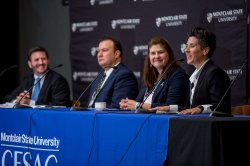Saving the Planet, Growing Jobs
Summit at Montclair State explores clean and sustainable energy

Leaders in government, technology, education and business met at the second annual Clean and Sustainable Energy Summit, presented by the Clean Energy and Sustainable Analytics Center (CESAC) at Montclair State University on September 26 to share information and discuss the initiatives that are putting New Jersey at the forefront of clean and sustainable energy in the U.S. and beyond.
“New Jersey is ground zero in the battle to protect our planet,” said Bob Gordon, commissioner, New Jersey Board of Public Utilities, in his keynote speech. He added that “the timing of this conference is significant,” as it followed on the heels of the worldwide student-led Climate Strike on September 20 and the U.N. Climate Action Summit on September 23 in New York.
“Since 1895, New Jersey’s average temperatures have risen about 3.6 degrees Fahrenheit, double the average for the lower 48 states,” said Gordon. But while New Jersey is facing climate impacts more intensively that other states – due largely to its highly developed nature and its large coastal area – its vulnerabilities are also its strengths: For example, the state is seeking to harness its coastal winds and provide accessible and affordable renewable energy in densely populated areas.
“New Jersey is truly doing things that are historic,” said Gordon.
Following on the release of the draft, New Jersey Energy Master Plan in June – which includes Gov. Phil Murphy’s stated goal of 100 percent clean energy for New Jersey by 2050 – the Clean and Sustainable Energy Summit addressed several aspects of this “road map to help usher the state into our clean energy future” with sessions on offshore wind, accessible and affordable solar energy, an improved and efficient power grid, data analysis and more.
One case in point: The 130 miles of New Jersey coastline are the nexus of plans to bring offshore wind to the state and build a supply chain of industries around it.
Kris Ohleth of Ørsted, a Danish firm that is leading the development of an 1,100-megawatt wind farm 15 miles off the coast of Atlantic City, noted that a supply chain as well as reliable transmissions are important for companies like hers. She said that the Atlantic City wind farm project, which should be operational by 2024, is the largest offshore wind project ever in the U.S. and Ørsted’s third largest in the world. “That’s a statement,” said Ohleth, “I’m from New Jersey. We like to make statements.”
Regarding workforce development, Brian Sabina, senior vice president of economic transformation for the New Jersey Economic Development Authority, said that New Jersey is “starting from a position of strength” with 90,000 “wind adjacent” employees. Sabina said that that state is working to create training programs with partners such as Montclair State University. “We’re creating a suite of solutions arming industries with the right people needed to fuel these industries.”
With undergraduate and graduate degrees in Earth and Environmental Sciences – including a PhD program in Environmental Science and Management – Montclair State is well-positioned as a partner.
“Montclair State University leads the way in engaging our community to find innovative solutions to our clean energy and sustainability challenges,” said Lora Billings, dean of the College of Science and Mathematics. “We are committed to workforce development in the areas of sustainability, technology, environmental science and management, and more. Our faculty, students and partners are ready to take the transformative action needed to tackle society’s most complex and pressing environmental problems.”
Montclair State is, of course, further positioned to aid in New Jersey’s energy transformation with CESAC. Its director, Pankaj Lal, explained the value of the summit: “It’s not just presentations. We want discussion. We want collaboration. We want government and community partnerships. We can foster that. We provide that forum where different stakeholders come in and they talk honestly. You saw that in the sessions.”
CESAC also serves a unique role: “With sustainability you need modeling,” said Lal. “The state needs that kind of information to make informed decisions. We see ourselves as an energy and environmental modeler. And we pride ourselves on that. When you put numbers to it, when it’s science based, when it’s evidence based, then people pay attention.”
